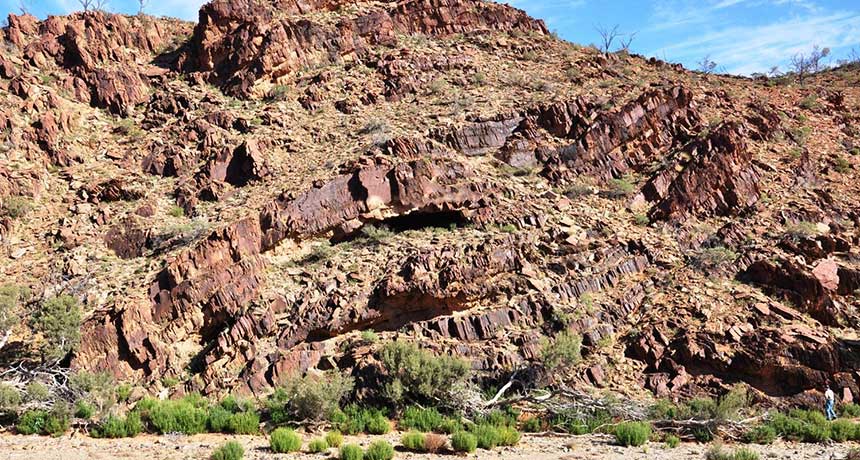People settled Australia’s rugged interior surprisingly early

Australia’s early settlers hit the ground running, or least walking with swift determination. After arriving on the continent’s northwest coast by around 50,000 years ago, humans reached Australia’s southeastern interior within a thousand years or so, researchers find.
This ancient trip covered more than 2,000 kilometers through terrain that, although stark and dry today, featured enough lakes and rivers at the time of Australia’s colonization to support long-distance treks, say archaeologist Giles Hamm of La Trobe University in Melbourne, Australia, and colleagues.
Excavations at Warratyi rock-shelter indicate that it took only a few millennia for Australia’s early colonists to forge a distinctive Aboriginal culture that continued to develop over the next 40,000 years, Hamm’s team reports online November 2 in Nature.
“Archaeological finds at Warratyi are surprisingly old and significant, especially coming from an excavation of only a meter of sediment,” Hamm says.
These new discoveries are “remarkable and atypical” for Australia, says archaeologist Peter Hiscock of the University of Sydney. But the finds’ ages and significance for understanding Aboriginal culture will be debated, he predicts.
Until now, the oldest human sites in Australia’s huge, arid interior dated to no more than 44,000 years ago in the continent’s northwest, not far from where the first settlers presumably arrived. Lake Mungo, now a dry lake bed in southeastern Australia, has yielded artifacts from about 50,000 years ago. Unlike artifacts at Warratyi that represent human activity over a long time span, it’s not known if Lake Mungo finds come from a group that made an isolated foray into the region before dying out within a few generations.
Hamm’s group unearthed evidence of an intermittent human presence at Warratyi that lasted from around 49,000 to 10,000 years ago. People were largely absent between around 35,000 and 17,000 years ago, when the climate became substantially colder and drier, Hamm says.
Finds at Warratyi dating to between 49,000 and 46,000 years ago include stone tools and a piece of reddish pigment. Bones from 16 mammal species and one reptile species were unearthed from various layers of sediment. Of particular interest were a partial leg bone from an extinct, rhino-sized marsupial and eggshells from a large, flightless bird. These animals died out not long after humans reached Australia, but it hasn’t been clear whether humans contributed to the extinctions via hunting or other actions ( SN: 1/20/07, p. 38 ).
Warratyi probably won’t resolve that issue. No butchery marks from stone tools appear on the marsupial fossil, although people may still have hunted the creature. Possibly burned areas appear on some eggshell fragments. Recent evidence from other Australian sites indicates that people were cooking this extinct bird’s eggs between 54,000 and 43,000 years ago.
Other discoveries at Warratyi indicate Aboriginal people there made a variety of tools up to 10,000 years before similar tool types were known to have occurred elsewhere in Australia or in Southeast Asia, the scientists say. For instance, a 4-centimeter-long bone point that dates to more than 38,000 years ago is Australia’s earliest known bone tool.
Comparably ancient discoveries include fragments of resin, which was probably used to glue stone tools to handles of some type. Tool handles probably came into use even earlier than that Down Under, argues archaeologist Sandra Bowdler of the University of Western Australia in Crawley. Researchers generally agree that, in Australia, stone cutting implements with ground, beveled edges were once attached to handles, Bowdler explains. A team led by Hiscock recently dated a ground-edge tool found in northwest Australia to between 49,000 and 44,000 years ago. That means handle use started there before it appeared at Warratyi, Bowdler holds.
Tools displaying sharpened edges along one side appear at Warratyi between 30,000 and 24,000 years ago. While Hamm’s team regards these as the oldest such implements in Australia, Bowdler awaits more thorough dating of Warratyi sediment layers before accepting that conclusion.
To date artifacts, Hamm’s group calculated the time since buried sediment was last exposed to sunlight and conducted radiocarbon analyses of charcoal from ancient hearths and of eggshell fragments.
Questions remain about the age of the oldest Warratyi discoveries, says geochronologist Richard Roberts of the University of Wollongong in Australia. Two samples of the deepest artifact-bearing sediment were dated to around 44,000 to 43,000 years ago, whereas three radiocarbon dates of eggshells from the same sediment ranged in age from possibly more than 50,000 years to perhaps more than 45,000 years, in Roberts’ view. If the younger age is the correct one, then Warratyi finds are no older than those previously discovered at Riwi rock-shelter, another site in Australia’s arid interior. If older than 50,000 years, Roberts says, “the Warratyi artifacts would be among the oldest on the continent.”